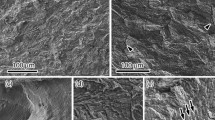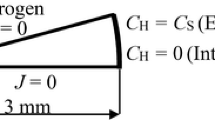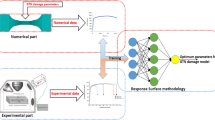Abstract
An investigation of the effects of hydrogen on tensile flow, strain-hardening and fracture characteristics of low nickel-type 316L austenitic stainless steel was quantified by means of slow strain rate tensile (SSRT) tests. Both thermal precharged and gaseous hydrogen conditions will be considered. The strain-hardening parameters were derived for an idealized true-stress/true-strain curve expressed by Hollomon’s equation. It was found that hydrogen affects the strain-hardening rate and reduces the overall strain-hardening exponents with a similar tendency for diminution of reduction area and fracture strain. The severity of hydrogen embrittlement was observed to be greater in a gaseous hydrogen environment than when tested in the hydrogen pre-charged specimen. Moreover, the fracture mechanism caused by hydrogen pre-charged and gaseous hydrogen environments were different. Hydrogen-induced cracks in hydrogen were found to appear at the interior of the grain boundary, in which there was a strain-induced martensite transformation phase, and crack formation at the grain boundary was predominant gaseous hydrogen specimens.
Similar content being viewed by others
References
NASA, Safety Standard for Hydrogen and Hydrogen Systems, Washington, D.C: NSS 1740.16 (1997).
C. San Marchi and B. P. Somerday, Technical reference on hydrogen compatibility of materials, Sandia National Laboratories, SANDIA REPORT SAND2008-1163 (2008) 1211–1311.
ANSI/CSA, CHMC 1-2014. Test Method for Evaluating Material Compatibility in Compressed Hydrogen Applications Phase-I-Metals, Mississauga, ON: Canadian Standards Association (2014).
R. P. Gangloff and B. P. Somerday, Gaseous Hydrogen Embrittlement of Materials in Energy Technologies: Mechanisms, Modelling and Future Developments, Elsevier (2012).
Y. Murakami, S. Matsuoka, Y. Kondo and S. Nishimura, Mechanism of Hydrogen Embrittlement and Guide for Fatigue Design, Tokyo, Yokendo (2012).
G. R. Caskey Jr., Hydrogen Compatibility Handbook for Stainless Steels No. DP-1643, Du Pont de Nemours (EI) and Co., Aiken, SC (USA), Savannah River Lab. (1983).
S. Matsuoka, J. Yamabe and H. Matsunaga, Criteria for determining hydrogen compatibility and the mechanisms for hydrogen-assisted, surface crack growth in austenitic stainless steels, Engineering Fracture Mechanics, 153 (2016) 103–127.
C. San Marchi, B. P. Somerday and K. A. Nibur, Development of methods for evaluating hydrogen compatibility and suitability, International Journal of Hydrogen Energy, 39 (35) (2014) 20434–20439.
S. Takaki, S. Nanba, K. Imakawa, A. Macadre, J. Yamabe, H. Matsunaga and S. Matsuoka, Determination of hydrogen compatibility for solution-treated austenitic stainless steels based on a newly proposed nickel-equivalent equation, International Journal of Hydrogen Energy, 41 (33) (2016) 15095–15100.
C. San Marchi, T. Michler, K. A. Nibur and B. P. Somerday, On the physical differences between tensile testing of type 304 and 316 austenitic stainless steels with internal hydrogen and in external hydrogen, International Journal of Hydrogen Energy, 35 (18) (2010) 9736–9745.
O. Takakuwa, J. Yamabe, H. Matsunaga, Y. Furuya and S. Matsuoka, Comprehensive understanding of ductility loss mechanisms in various steels with external and internal hydrogen, Metallurgical and Materials Transactions A, 48 (11) (2017) 5717–5732.
O. Takakuwa, J. Yamabe, H. Matsunaga, Y. Furuya and S. Matsuoka, Recent progress on interpretation of tensile ductility loss for various austenitic stainless steels with external and internal hydrogen, Proceeding of the ASME 2017 Pressure Vessels and Piping Conference (PVP2017) (2017).
C. San Marchi, B. P. Somerday, X. Tang and G. H. Schiroky, Effects of alloy composition and strain hardening on tensile fracture of hydrogen-precharged type 316 stainless steels, International Journal of Hydrogen Energy, 33 (2) (2008) 889–904.
L. Zhang, M. Wen, M. Imade, S. Fukuyama and K. Yokogawa, Effect of nickel equivalent on hydrogen gas embrittlement of austenitic stainless steels based on type 316 at low temperatures, Acta Materialia, 56 (14) (2008) 3414–3421.
G. Han, J. He, S. Fukuyama and K. Yokogawa, Effect of strain-induced martensite on hydrogen environment embrittlement of sensitized austenitic stainless steels at low temperatures, Acta materialia, 46 (13) (1998) 4559–4570.
Y. Mine, Z. Horita and Y. Murakami, Effect of hydrogen on martensite formation in austenitic stainless steels in high-pressure torsion, Acta Materialia, 57 (10) (2009) 2993–3002.
S. Sun, G. Han, S. Vaodee, S. Fukuyama and K. Yokogawa, Tensile behaviour of type 304 austenitic stainless steels in hydrogen atmosphere at low temperatures, Materials Science and Technology, 17 (3) (2001) 302–308.
T. Michler, A. Yukhimchuk and J. Naumann, Hydrogen environment embrittlement testing at low temperatures and high pressures, Corrosion Science, 50 (12) (2008) 3519–3526.
Y. Wada, R. Ishigaki, Y. Tanaka, T. Iwadate and K. Ohnishi, Effect of hydrogen gas pressure on the mechanical properties of low alloy steel for hydrogen pressure vessels, ASME 2007 Pressure Vessels and Piping Conference, American Society of Mechanical Engineers (2017) 481–489.
C. M. Kim, Y. P. Kim and W. S. Kim, Influence of gaseous components and pressures on hydrogen embrittlement of natural gas pipeline, Journal of Mechanical Science and Technology, 31 (8) (2017) 3691–3695.
S. J. Yoon, H. J. Lee, K. B. Yoon, Y. W. Ma and U. B. Baek, Hydrogen damage in 34CrMo4 pressure vessel steel with high tensile strength, Journal of Mechanical Science and Technology, 32 (2) (2018) 637–646.
ASTM G142-98, Standard test method for determination of susceptibility of metals to embrittlement in hydrogen containing environments at high pressure, high temperature, or both, ASTM International: West Conshohocken, PA, 4 (2004).
ASTM, A240/A240M-17, Standard specification for chromium and chromium-nickel stainless steel plate, sheet, and strip for pressure vessels and for general applications, ASTM International, West Conshohocken, PA Std (2017).
U. B. Baek, T. T. Nguyen, S. H. Nahm and K. S. Ryu, Ductility and fatigue strength loss of hydrogen-charged 316L austenitic stainless steel, Proceedings of the ASME 2019 Pressure Vessels & Piping Conference (PVP2019) (2019).
J. H. Hollomon, Tensile deformation, Aime Trans, 12 (4) (1945) 1–22.
A. Nagao, C. D. Smith, M. Dadfarnia, P. Sofronis and I. M. Robertson, The role of hydrogen in hydrogen embrittlement fracture of lath martensitic steel, Acta Materialia, 60 (13-14) (2012) 5182–5189.
Acknowledgments
This research was supported by Development of Reliability Measurement & Standard Technology for Hydrogen Fueling Station funded by Korea Research Institute of Standards and Science (KRISS-2019-GP2019-0012). This research was also supported by the Korea Institute of Energy Technology Evaluation and Planning (KETEP) and Ministry of Trade, Industry & Energy of the Republic of Korea [No. 201622 20100180, a study on risk assessment of hydrogen multi energy filling station].
Author information
Authors and Affiliations
Corresponding author
Additional information
Recommended by Associate Editor Zhuhua Tan
Thanh Tuan Nguyen received his Ph.D. in Mechanical Engineering from Chung-Ang University, Korea in 2018. He is currently working as a post-doctoral fellow at the Korea Research Institute of Standard and Science. His research interests are failure analysis, high-temperature fracture mechanics and the effect of gaseous hydrogen environments on the mechanical properties of materials.
Jaeyeong Park received his Ph.D. in Material Science Engineering from Pohang University of Science and Technology, Korea in 2018. He is currently working as Senior Researcher at the Korea Research Institute of Standard and Science. His research interests are materials science and the mechanical behaviour of materials at high temperature, including anisotropic materials such as gas turbine blades.
Seung Hoon Nahm received his Ph.D. in Mechanical Engineering from Kyung-pook National University, Korea in 1997. He is currently working as Principal Research Scientist at the Korea Research Institute of Standard and Science. His research interests are the mechanical behaviour of materials at the micro and nano scales, hydrogen embrittlement and mechanical behaviour of materials at high temperature.
Un Bong Baek received his Ph.D. in Mechanical Engineering from Kyung-pook National University in 2001. He worked at Georgia Institute of Technology, U.S.A. as a post-doctoral fellow during 2002-2003. Dr. Baek is currently Director of the Centre for Energy and Material Metrology of KRISS (Korea Research Institute of Standards and Science). His research interest is in the mechanical behaviour of materials in high-pressure hydrogen environments.
Rights and permissions
About this article
Cite this article
Nguyen, T.T., Park, J., Nahm, S.H. et al. Effect of hydrogen on tensile flow and failure mechanism of low nickel-type 316L austenitic stainless steel. J Mech Sci Technol 33, 5843–5849 (2019). https://doi.org/10.1007/s12206-019-1131-2
Received:
Revised:
Accepted:
Published:
Issue Date:
DOI: https://doi.org/10.1007/s12206-019-1131-2




